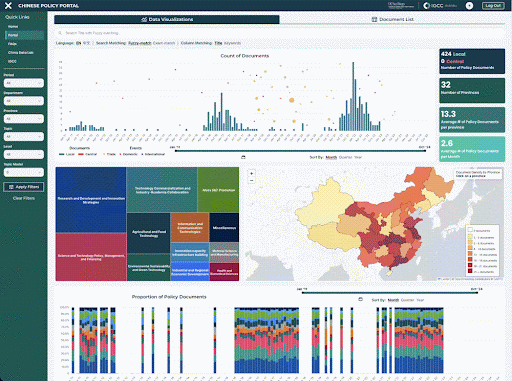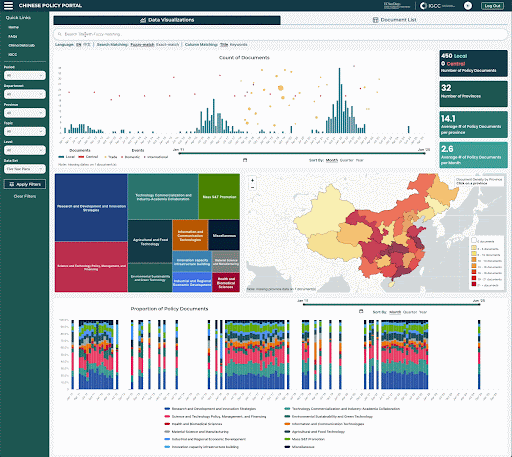China’s Science & Technology Ecosystem, Made Searchable
Introducing the China Policy Document Navigator
China’s drive to lead in science and technology is guided by an ever-expanding array of policies, from flagship Five-Year Plans to local circulars on AI, semiconductors, and green energy. But these policy documents are often fragmented across different levels of government, inconsistently published, and sometimes removed from the web. Now, for the first time, the China Policy Document Navigator(https://portals.igcc.sdsc.edu) gives the public structured access to China’s evolving innovation policy landscape.

What’s Inside: A “Policy Atlas” of China’s Innovation Strategy
The Policy Document Navigator is an interactive database and visualization tool that maps who issued what policy, when, and where, visualizing how agendas shift across time and space.

Policy Document Navigator dashboard: surge of documents after 2015.
- Breadth and depth: the navigator Includes curated flagship plans (e.g., Five-Year Plans at national, provincial, and prefectural levels, plus strategic and future industry roadmaps) as well as tens of thousands of science, technology, and innovation (STI)-related regulations, guidelines, and program announcements.
- Useful Filters: Search by keyword (Chinese and English), date range, issuing department, or province/prefecture.
- Topic views: Explore 13 grouped themes (from AI and frontier technologies to environmental sustainability) powered by advanced topic modeling.
- Visual dashboards: Charts and maps show diffusion of policies across geographies and over time.

Provincial distribution of policy counts. Hotspots include Beijing, Jiangsu, and Guangdong.
Interesting Stories the Navigator Reveals
- AI takes off everywhere: After Beijing’s release of the New Generation AI Development Plan in 2017, local governments rushed to issue their own AI policies. By 2018, provinces as diverse as Heilongjiang and Guangxi were embedding AI everywhere from agriculture to healthcare, showing how quickly central priorities localize.
- Policy bursts tell stories: A spike of documents on “new energy vehicles” in 2020 aligns with China’s national carbon neutrality pledges. Provinces like Guangdong and Shanghai moved fast to push subsidies and infrastructure, revealing how global commitments filter down to local plans.
- Quantum is concentrated: In contrast, quantum computing policies remain clustered around research hubs like Beijing, Jiangsu, and Anhui. While AI spreads broadly as a general-purpose technology, quantum stays anchored in specialized provinces with existing research capacity.

These kinds of patterns across themes, timelines, and regions were nearly impossible to trace systematically before.
Why This Matters
- Transparency in a low-transparency environment: Preserves access to documents that may be selectively released or later removed.
- Connects dots across regions: Shows how Beijing’s high-level ambitions cascade into local implementation.
- Evidence over anecdotes: Moves analysis beyond one-off examples toward comprehensive, comparable datasets.
How to use the portal
- Register for a free account on the landing page.
- Search and filter policies in Chinese or English.
- Visualize patterns in the interactive dashboards.
- Export metadata or request authorized access for full-text and batch downloads.
A detailed walkthrough
- Explore AI diffusion: Start by typing “人工智能 / Artificial Intelligence” into the search bar. Set the date range from 2017–2022. The histogram will reveal a sharp jump in AI-related documents right after the release of the national plan. Toggle the map view to see how provinces from Beijing to Guizhou issued their own AI policies, often targeting region-specific industries like healthcare, education, or manufacturing.

AI-related documents surge after 2017, spreading quickly across provinces.
- Compare sectors: Switch the topic to “Quantum Computing.” You’ll notice far fewer documents overall, concentrated in provinces with major research capacity. The topic visualization highlights that most of these focus on research and funding mechanisms rather than applied uses.
- Trace carbon neutrality pledges: Search for “新能源汽车 / New Energy Vehicles.” Set filters for 2018–2022 and select issuers like MIIT and provincial DRCs. The line chart shows bursts of policy activity in 2020–21, reflecting China’s announcement of its 2060 carbon neutrality goal. The geographic distribution reveals leadership from coastal provinces like Guangdong and Shanghai, paired with central government pushes.

Policies on new energy vehicles spiked around China’s 2060 carbon neutrality pledge.
- Customize your dataset: Combine filters. For instance, you could try, “AI” + “Healthcare” + “Guangxi Province.” Export the resulting metadata to build a reproducible corpus for deeper analysis.
These walkthroughs show how quickly you can move from broad policy questions (“When did AI become a priority nationwide?”) to finer-grained analysis (“Which provinces applied AI to agriculture first?”).
Credits & hosting
The Policy Document Navigator is developed by the UC Institute on Global Conflict and Cooperation (IGCC) and China Data Lab (21st Century China Center, UC San Diego). Data are securely hosted at the UC San Diego Supercomputer Center (SDSC) and made accessible to the public.
Explore the Navigator here: https://portals.igcc.sdsc.edu/








